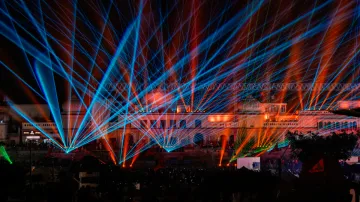Ram Mandir consecration: Ayodhya, the holy city of Lord Ram, where the grand temple will be inaugurated today (January 22), has undergone a paradigm shift fuelled by massive infrastructure growth in the recent past, with Ram temple being at its heart. It was the 2019 Supreme Court verdict on the fractious Ramjanmabhoomi-Babri Masjid issue that paved the way for the progress of this pilgrim city which till a few years ago was a sleepy town in Uttar Pradesh.
A new chapter will be written on Monday in the history of Ayodhya, also India, as the consecration ceremony takes place at the Ram Mandir which will be attended by Prime Minister Narendra Modi and over 7,000 guests.
A series of events have taken place ahead of ‘Pran Pratishtha’, as part of which massive infrastructural projects have been implemented on the ground in the temple town to turn it into what the government calls a 'Bhavya, Divya and Navya Ayodhya'.
Development in Ayodhya
With a swanky new airport, a redeveloped railway station, two widened roads -- Ram Path and Dharm Path -- which are now showpiece streets, multi-level car parking facilities, e-buses, a dedicated multilingual tourist app, and new luxury hotels on the horizon, Ayodhya has changed and so has its image.
Falling in line with Prime Minister Narendra Modi’s vision of 'Vikas bhi, Virasat bhi', this infrastructure push has also embraced the heritage of the ancient city, where Lord Ram was born.
The airport and the railway station, both equipped with modern facilities, bear a cladding of sandstone with the design drawn from the architectural elements of the newly built Ram temple which uses sandstones sourced from Rajasthan.
"Ayodhya is undergoing a 'nav nirman' (new construction) and infrastructure is changing...We have to give a new identity to Ayodhya at the global level," Uttar Pradesh Chief Minister Yogi Adityanath said recently after flagging off a fleet of e-buses for the city.
The state government's infrastructure expansion is driven and centred around this grand temple whose 'bhoomipujan' was performed by Modi in August 2020.
Built in the traditional Nagara style, it will be 380 feet long (east-west direction), 250 feet wide and 161 feet high.
Each floor of the three-storey temple will be 20 ft high and have a total of 392 pillars and 44 gates.
To facilitate devotees to reach this temple, the government has redeveloped four roads, including the 13-km Ram Path from Sahadatganj to Naya Ghat Chouraha -- for which partial demolition of a large number of shops, houses and other buildings had to be carried out.
The widened Ram Path with uniform facades of buildings on both sides, ornamental lamp posts bearing a design representing the traditional 'Ramanadi tilak' and the 40 Surya Stambhs installed along Dharm Path and the Lata Mangeshkar Chowk are new tourist attractions in the city.
(With PTI inputs)
ALSO READ | Ram Mandir consecration: Indian diaspora celebrates at Times Square, chants ‘Jai Shri Ram' | WATCH
ALSO READ | Ram Mandir Pran Pratishtha: Ram Lalla idol bathed with water brought in kalash from pilgrimage sites
